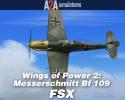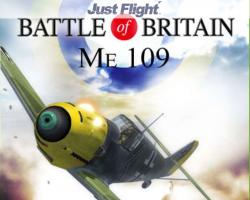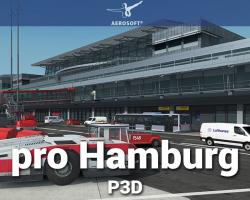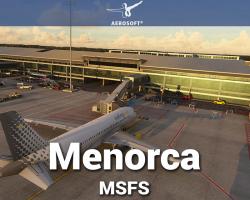Wings of Power II: Messerschmitt Bf 109 for FSX

Although many flight simulation products specifically concentrate on the aviation from an Allied point of view, the German aircraft during the Second World War was a sight to behold, as well. As one of the most important and most regularly created fighters throughout the entirety of the war – with more than 30,000 of this fantastic model created – it was comfortably one of the most numerous fighters seen throughout the entire war and served as a real force in the skies prior to the counteraction by the Allies which eventually turned the tide of the entire war. Read more...
- Media Format
- Immediate Download
- Compatibility
- Microsoft Flight Simulator X
- File size
- 70 MB
- Developer
- A2A Simulations
The Messerschmitt Bf 109
The aircraft first took to the skies in 1935, and ironically was fitted with a Rolls Royce engine – a cruel twist of fate for things to come in the future for both sides. Although many of its first pilots were not impressed due to being used to the aircraft models and styles that were regularly seen during the First World War, it was eventually pushed through despite complaints and was developed with a DB 601 engine instead of using the British-made parts as the basis for the aircraft – and it proved dividends during the conflict, providing the Bf 109 with power and pace.
Despite the obvious limitations of the aircraft – a lack of range most notable being the problem, along with an inferior diving capability in comparison to the equally rapid Spitfire – it served as one of the most important part of the German air force until the 1940s, when they were lost in heavy numbers. Weighted down by the under-wing heaters and a rather choked control scheme after continuous flight, the rigid nature in the design and style of the Bf 109 held it back from being a true competitor in the skies for later British aircraft.
Even with these limitations included in the discussion, though, the Bf 109 was more than a match for any British models that they came up against if it was commandeered by the right quality of pilot. One of its main competitors was the Hurricane, and it still held many positives over the Hurricane through sheer power. The main thing that held back the Bf 109 was a lack of time and resources put into the development of the project – it was an aircraft that needed a lot of work done to it, and was eventually outstripped by its more modern rivals.
In this package, you will finally get to take to the skies in one of the most prominent of the Axis war force – complete with all of its limitations and recreated in the most stunning detail possible, this remake of the Bf 109 gives you all the help that you need in really getting into the spirit of Second World War aviation. Complete with all of those little changes and additions that help make each and every aircraft feel unique, you’ll truly feel the difference between the Bf109 and the Spitfire thanks to A2A Simulations.
Flight Specifications
-
This version follows the later versions of the Bf 109 E-4, which is arguably the most popular and beloved of all the models that were created. This modification takes all of those key details and puts them into action – you will be equipped with the DB601A engine as well as the single 20mm cannon that the Bf cam with through the propeller shaft. You’ll also have the twin 7.92mm machine guns in the cowling, matched on the wings with equal firepower. Now, you’ll really have all of the right firepower that the Axis used back in the War!
-
The attention to detail in the way that the payload operates and the fuelling is dealt with is spectacular; having spent many hours studying into the history and philosophy of the actual aircraft, the actual payload has been re-created perfectly. Depending on the load-outs that are taken, the aircraft can go from 18.9% CG to 26.8% - it all depends entirely what you decide to take with you, making a decision to be made on how you will be flying your Bf 109. Now, you’ll have to make sure that you’ve got the right weight balance for the style of flight you intended to take on!
-
All of the smaller things most certainly count when you look into the way that an aircraft operates; when on the ground, an aircraft like this will typically be fairly tail-heavy. Therefore, you can use the breaks to your own needs without compromising the aircraft or risking the chances of “nosing up” or damaging the propellers in any fashion. All of these little things have been included in the overall design, ensuring that authenticity reigns supreme. The specifications of each part of the flight have been created with accuracy as the aim at all times
-
A complete set of cockpit controls have been included and improved upon to make sure that you get a cockpit that looks like the real thing. The most important part of any flight is being able to master the cockpit, and the best way to do this is to follow the real instructions. Every last detail that has been included is following the real pattern and style of the Bf 109 in the first place’ from the 12:00 positioning of the propeller control to the elevator trim being set to neutral, everything that can be included has been effectively
-
Various other controls have been included to give you total reign over things like the radiator shutters, the mixture control to help you manage the fuel effectively throughout the flight, and even to control the propellers. Struggling to get going in the wind? You’ll need to adjust the propeller system using the system – you’ll be able to place the propeller in ranges from 22.5-90 degrees, giving you a totally different flight style as you go. This allows you to adjust the flight perfectly, but requires that extra level of detail and attention on the part of the pilot’ overall awareness
How to Use
Using this aircraft can be fairly challenging – the main thing that you need to do look out for is that you are following the specific startup policies, and that you read the following sections to fully understand how to fly the aircraft, and how to maintain its overall style and performance. These simple steps will help you keep the right track as you fly, and make sure that you get to where you intended to go with your new Bf 109!
Starting the Engine
- Complete a basic cockpit check
- Ensure that the brakes are on hold
- Turn the battery switch on
- Turn the re-check fuel supply on
- Ensure the magneto switch is set to both
- Set the fuel cut-off controls to o
- Use the manual fuel pumps to ensure that the fuel lines are adequately pressurized
- If the engine is cold, then use the priming pump 3-4 times to prime the engine for use
- Turn the master ignition on
- Engage the starter switch, until the engine eventually starts – this can take a few turns!
-
Check that all engine instruments are accurate, and check that the oil pressure is capable of rising to 4kg/cm2 within a 30-second time period
- Fuel pressure should be able to rise to at least 1-1.8 kg/cm2
- Stay idle at 700 RPM until the oil temperature reaches 30 degrees
- Turn on the generator, and then the avionics
- Ensure that all instruments are working effectively
- Once the warm-up is finished, go to idle at 800 RPM or just under
Pre-Take Off Procedure
- Ensure that the elevator trim tab has been adjusted properly
- Once ready, double-check that the prop is set to 11:30 on the pitch clock
- Set the re-check fuel to on
- Check the flaps are set at 20 degrees
- Check that your radiator flaps are open
- Test the brakes to ensure they work as they should
- Check the magnetos are at 1900RPM – you only want to see a maximum drop of 150 RPM
Take-Off
Typically, the take-off procedure for using the Bf 109 is quite different compares to what you might usually be used to, especially in comparison to other Second World War fighters. Due to the tail-heavy nature of the aircraft, you have an extra layer of stability and have no need for using a tail wheel lock. However, when taking off, you need to hold the stick forward instead of back as well as to the right, making sure it’s in the right corner of the cockpit. Once you reach a speed of around 100 kph IAS, you will start to balance out properly.
Don’t make any attempts to come up off the ground too early, though; if the leading edge slats deploy for the vehicle too quickly then you can have a serious control issue. Ensure that you hold the aircraft level on the main wheels and that you have an appropriate flying speed before attempting any kind of take-off, before lifting off gently into the sky.
Once you have retracted the gear and the flaps, you can start to climb normally.
Controlling the Climb
Next, you need to make sure that you are actually taking off properly; this can be a bit of a problem for some pilots when they first start using this package. To avoid the problem, make sure that your standard climb is made at around 250 kph IAS at sea level, with a manifold pressure of around 1.25 ATA and the engine running at 2400RPM. If you want to get the best performance possible during the climb, try and climb at around 1.3 and 2500RPM for around five minutes – this will let you get the biggest jump in the shortest span of time.
Engine Limitations
As you might expect, this aircraft carries all of the usual hallmarks of an A2A creation; it’s got all of the real limitation that the Bf 109 suffered from. The DB601Aa engine that is encased in the aircraft can deal with medium altitudes just fine, but afterwards it can start to struggle slightly. Although it has a supercharger included to help to reach top speeds more efficiently at higher altitudes, you should only use the Emergency power functions for brief time periods – five minutes at any given time. This will help to conserve the engine and ensure that the aircraft flies properly.
Landing the Aircraft
-
Ensure that your fuel is ON
-
Set the prop to around 2400 RPM
-
Check that you have full clearance to land at the designated airport
-
Slow down to around 350 kph IAS, and start to lower your landing gear – if you need to retrim, do so
-
Lower the flaps to 20 degrees once you reach a speed of around 250 kph IAS – this takes time so make sure you time it right and give yourself enough time and space
-
Typically, the normal landing speed would be around 200 kph IAS – especially for when the wheels come down
-
For the last part of landing, come in at around 150 kph IAS, and once you reach the runway threshold reduce by 5 to 145 kph IAS
-
Break the glide just as you start to hover above the runway and touch down with the tail wheel just slightly off the ground, and start to gently bring he tail wheel gently
-
Break as necessary to help make your descent clear and simple – if you find that landing has become difficult or even compromised, start to aggressively use the brakes to help balance the aircraft out and land safely
Stalling & Spinning
Just like any good Second World War aircraft, these aircraft aren’t very good at dealing with spins! You’ll lose a lot of altitude if you don’t get it right and can cause the aircraft to become very close to being put out of commission! Additionally, dealing with stalls is part and parcel of flying the Bf 109. You’ll find that stalls are usually very mild and are recovered from quite quickly, so you don’t have too much to worry about with regard to the aircraft cutting out!
Customer Reviews
Rated 4.0/5.0 based on 1 customer reviews
- 04/24/2018
-
4/5 Verified Purchase

good plane to fly, unfortunately not working in P3D
Submit a review of this product
Do you own a copy of this add-on? Have you used it? We'd love to hear your feedback on it below. You don't even need to have purchased it from SimShack.





















